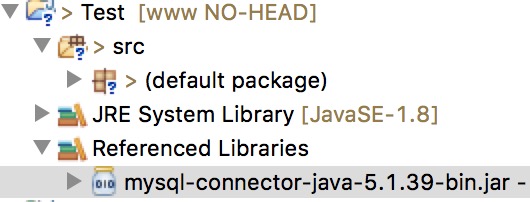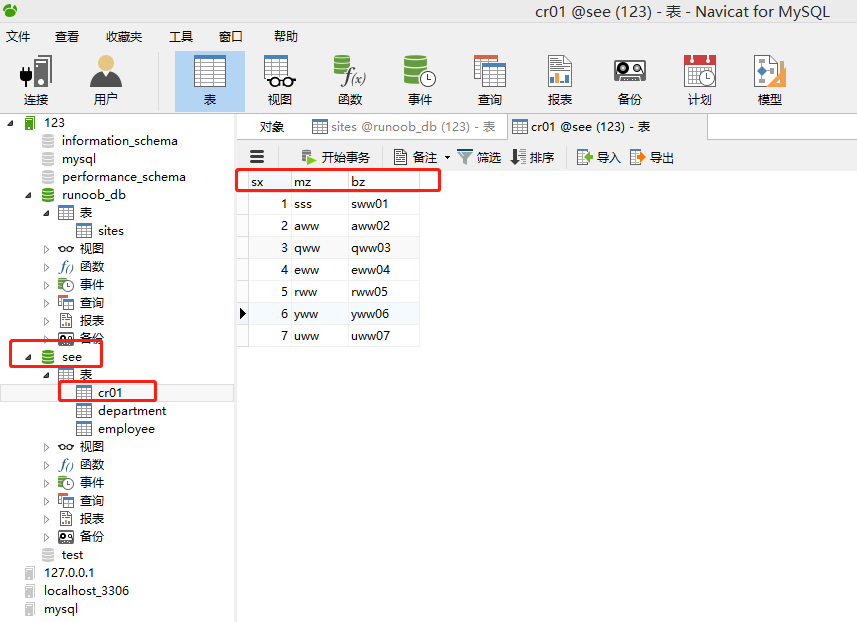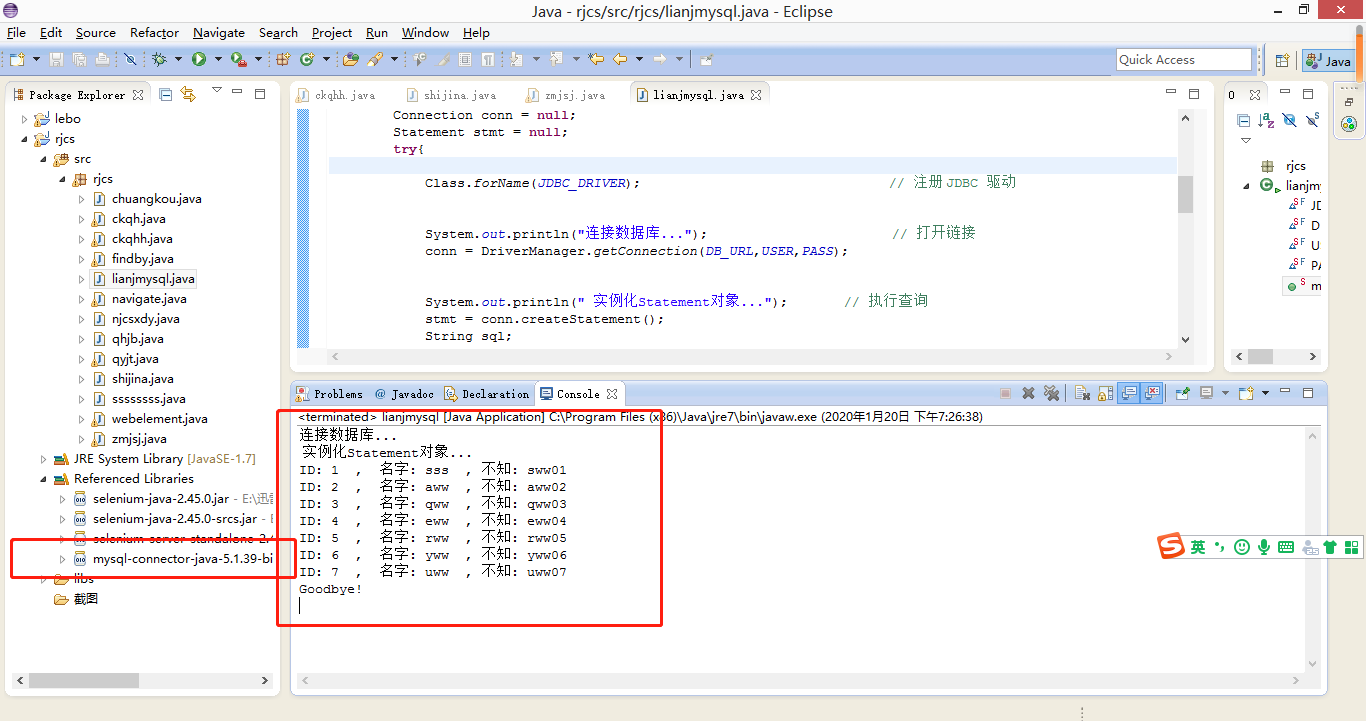java下连接mysql数据库 ——查询语句——select
Java MySQL 连接
本章节我们为大家介绍 Java 如何使用 使用 JDBC 连接 MySQL 数据库。
Java 连接 MySQL 需要驱动包,最新版下载地址为:http://dev.mysql.com/downloads/connector/j/,解压后得到jar库文件,然后在对应的项目中导入该库文件。
你可以下载本站提供的 jar 包:mysql-connector-java-5.1.39-bin.jar
本实例使用的是 Eclipse,导入 jar 包:

MySQL 8.0 以上版本的数据库连接有所不同:
1、MySQL 8.0 以上版本驱动包版本 mysql-connector-java-8.0.16.jar。
2、com.mysql.jdbc.Driver 更换为 com.mysql.cj.jdbc.Driver。
MySQL 8.0 以上版本不需要建立 SSL 连接的,需要显示关闭。
最后还需要设置 CST。
加载驱动与连接数据库方式如下:
Class.forName("com.mysql.cj.jdbc.Driver"); conn = DriverManager.getConnection("jdbc:mysql://localhost:3306/test_demo?useSSL=false&serverTimezone=UTC","root","password");
数据库数据

连接数据库
以下实例使用了 JDBC 连接 MySQL 数据库,注意一些数据如用户名,密码需要根据你的开发环境来配置:
package rjcs; import java.sql.*; public class lianjmysql { // MySQL 8.0 以下版本 - JDBC 驱动名及数据库 URL static final String JDBC_DRIVER = "com.mysql.jdbc.Driver"; static final String DB_URL = "jdbc:mysql://localhost:3306/see"; // MySQL 8.0 以上版本 - JDBC 驱动名及数据库 URL //static final String JDBC_DRIVER = "com.mysql.cj.jdbc.Driver"; //static final String DB_URL = "jdbc:mysql://localhost:3306/RUNOOB?useSSL=false&serverTimezone=UTC"; // 数据库的用户名与密码,需要根据自己的设置 static final String USER = "root"; static final String PASS = "123"; public static void main(String[] args) { Connection conn = null; Statement stmt = null; try{ Class.forName(JDBC_DRIVER); // 注册 JDBC 驱动 System.out.println("连接数据库..."); // 打开链接 conn = DriverManager.getConnection(DB_URL,USER,PASS); System.out.println(" 实例化Statement对象..."); // 执行查询 stmt = conn.createStatement(); String sql; sql = "SELECT sx, mz, bz FROM cr01"; ResultSet rs = stmt.executeQuery(sql); // 展开结果集数据库 while(rs.next()){ // 通过字段检索 int sx = rs.getInt("sx"); String mz = rs.getString("mz"); String bz = rs.getString("bz"); // 输出数据 System.out.print("ID: " + sx); System.out.print(" , 名字: " + mz); System.out.print(" , 不知: " + bz); System.out.print("\n"); } // 完成后关闭 rs.close(); stmt.close(); conn.close(); }catch(SQLException se)
{ // 处理 JDBC 错误 se.printStackTrace(); }catch(Exception e)
{ // 处理 Class.forName 错误 e.printStackTrace(); }finally
{ // 关闭资源 try{ if(stmt!=null) stmt.close(); }catch(SQLException se2){ }// 什么都不做 try{ if(conn!=null) conn.close(); }catch(SQLException se){ se.printStackTrace(); } } System.out.println("Goodbye!"); } }
执行结果:
连接数据库...
实例化Statement对象...
ID: 1 , 名字: sss , 不知: sww01
ID: 2 , 名字: aww , 不知: aww02
ID: 3 , 名字: qww , 不知: qww03
ID: 4 , 名字: eww , 不知: eww04
ID: 5 , 名字: rww , 不知: rww05
ID: 6 , 名字: yww , 不知: yww06
ID: 7 , 名字: uww , 不知: uww07
Goodbye!

package rjcs; import java.sql.*; public class lianjmysql { // MySQL 8.0 以下版本 - JDBC 驱动名及数据库 URL static final String JDBC_DRIVER = "com.mysql.jdbc.Driver"; static final String DB_URL = "jdbc:mysql://localhost:3306/see"; // MySQL 8.0 以上版本 - JDBC 驱动名及数据库 URL //static final String JDBC_DRIVER = "com.mysql.cj.jdbc.Driver"; //static final String DB_URL = "jdbc:mysql://localhost:3306/RUNOOB?useSSL=false&serverTimezone=UTC"; // 数据库的用户名与密码,需要根据自己的设置 static final String USER = "root"; static final String PASS = "123"; public static void main(String[] args) { Connection conn = null; Statement stmt = null; try{ Class.forName(JDBC_DRIVER); // 注册 JDBC 驱动 System.out.println("连接数据库..."); // 打开链接 conn = DriverManager.getConnection(DB_URL,USER,PASS); System.out.println(" 实例化Statement对象..."); // 执行查询 stmt = conn.createStatement(); String sql; sql = "SELECT sx, mz, bz FROM cr01"; ResultSet rs = stmt.executeQuery(sql); // 展开结果集数据库 while(rs.next()){ // 通过字段检索 int sx = rs.getInt("sx"); String mz = rs.getString("mz"); String bz = rs.getString("bz"); // 输出数据 System.out.print("ID: " + sx); System.out.print(" , 名字: " + mz); System.out.print(" , 不知: " + bz); System.out.print("\n"); } // 完成后关闭 rs.close(); stmt.close(); conn.close(); }catch(SQLException se){ // 处理 JDBC 错误 se.printStackTrace(); }catch(Exception e){ // 处理 Class.forName 错误 e.printStackTrace(); }finally{ // 关闭资源 try{ if(stmt!=null) stmt.close(); }catch(SQLException se2){ }// 什么都不做 try{ if(conn!=null) conn.close(); }catch(SQLException se){ se.printStackTrace(); } } System.out.println("Goodbye!"); } }


